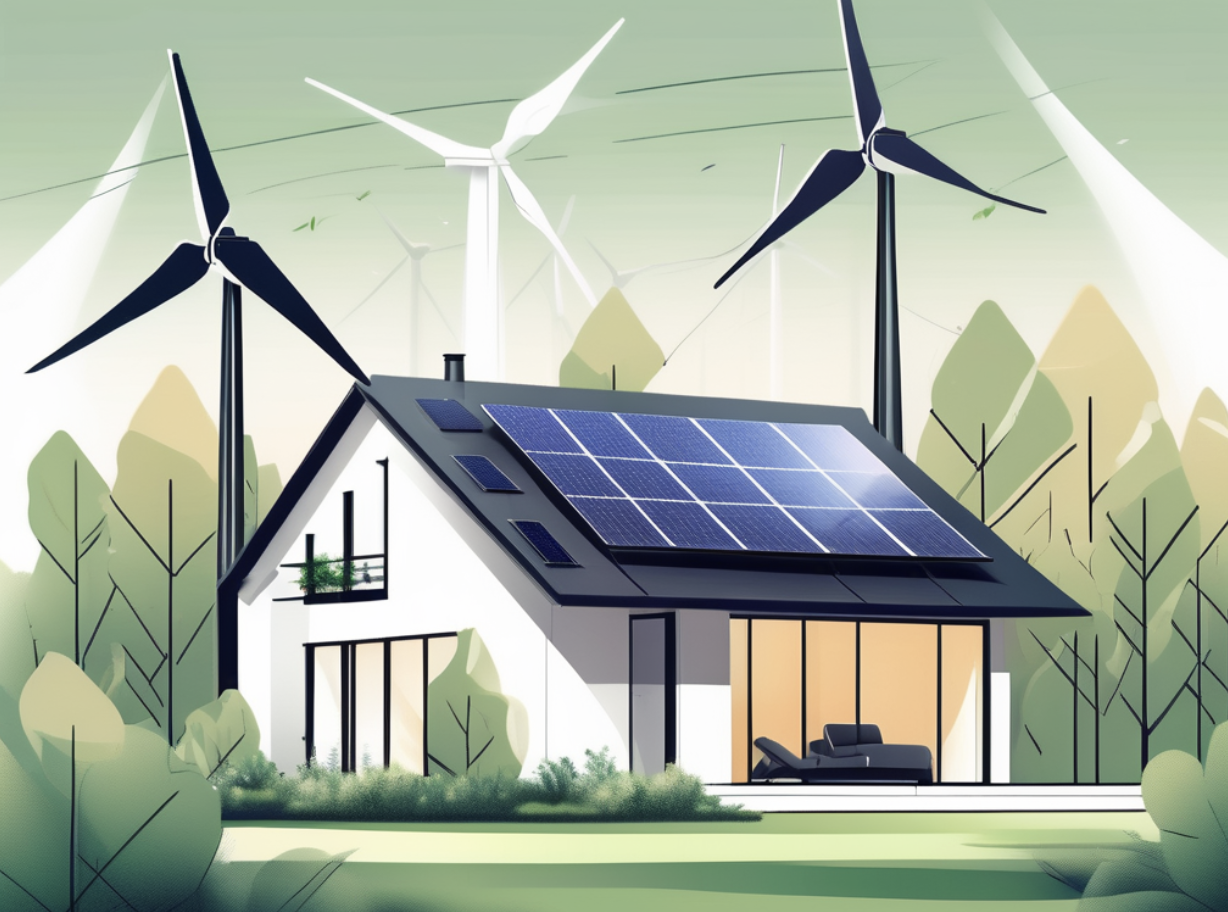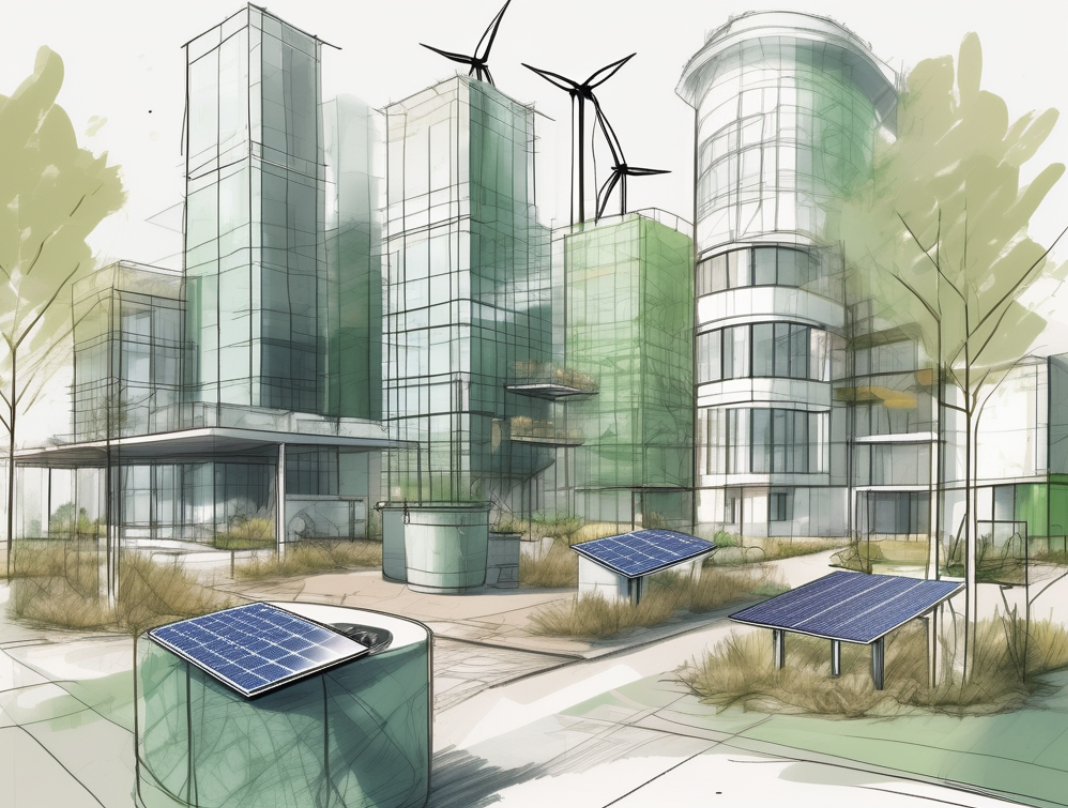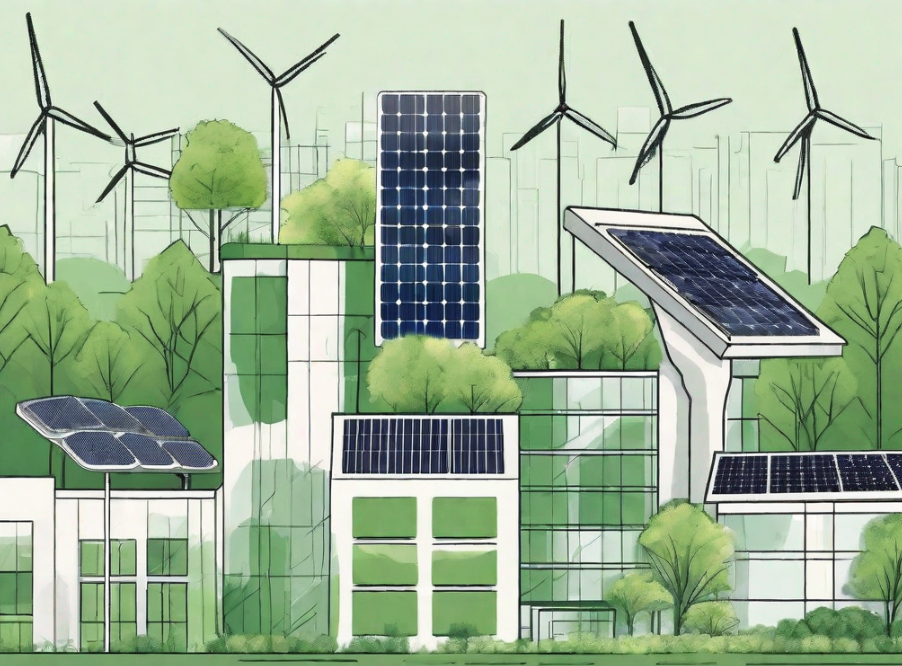Sustainable real estate – All you need to know
Sustainable real estate – All you need to know
Discover the ins and outs of sustainable real estate in this comprehensive guide.

Sustainable real estate is becoming increasingly important in today’s world as we strive for a more environmentally friendly and economically viable future. By implementing sustainable practices in real estate development, we can not only protect the environment but also create long-term value for investors, homeowners, and society as a whole. In this article, we will explore the various aspects of sustainable real estate and how it is revolutionizing the industry.

The Importance of Sustainable Real Estate Development
The Importance of Sustainable Real Estate Development
Sustainable real estate development is crucial for mitigating the environmental impact of the construction industry. By using eco-friendly materials and energy-efficient designs, developers can reduce carbon emissions and conserve natural resources. This not only benefits the environment but also helps in creating a more sustainable future for generations to come.
One of the key aspects of sustainable real estate development is the use of eco-friendly materials. These materials are sourced from renewable resources and have a lower carbon footprint compared to traditional building materials. For example, using bamboo flooring instead of hardwood not only reduces deforestation but also provides a durable and aesthetically pleasing alternative. Similarly, utilizing recycled materials, such as reclaimed wood or recycled concrete, reduces the demand for new resources and minimizes waste.
In addition to eco-friendly materials, energy-efficient designs play a vital role in sustainable real estate development. Incorporating features like solar panels, energy-efficient appliances, and proper insulation can significantly reduce energy consumption and lower utility costs for residents. Moreover, the use of smart technologies, such as automated lighting and thermostats, can optimize energy usage and enhance the overall sustainability of the development.
Furthermore, sustainable developments often prioritize creating healthy and comfortable living spaces for residents, which can have a positive impact on their overall well-being. Incorporating green spaces, such as parks and gardens, not only enhances the aesthetic appeal of the development but also provides opportunities for outdoor activities and promotes a sense of community. Additionally, sustainable buildings often prioritize indoor air quality by utilizing ventilation systems that filter pollutants and reduce the risk of respiratory diseases.
Moreover, sustainable real estate contributes to the overall resilience of cities and communities. By incorporating green spaces, efficient transportation systems, and smart infrastructure, developers can create vibrant and sustainable neighborhoods that promote a high quality of life for residents. For instance, designing walkable communities with access to public transportation not only reduces reliance on cars but also promotes physical activity and reduces air pollution. Furthermore, integrating smart technologies, such as renewable energy systems and water conservation measures, can enhance the resilience of the development to climate change and natural disasters.
Understanding the Principles of Sustainable Real Estate
Understanding the Principles of Sustainable Real Estate
The principles of sustainable real estate revolve around three key pillars: environmental, economic, and social sustainability.
Environmental sustainability entails reducing the negative impact of a building on the environment. This can be achieved through energy-efficient design, the use of renewable energy sources, water conservation measures, waste reduction strategies, and the preservation of natural habitats.
Economic sustainability focuses on ensuring the long-term economic viability of a real estate project. By incorporating sustainable features, developers can reduce operational costs, attract eco-conscious tenants, and future-proof their investments against changing regulations and consumer preferences.
Social sustainability emphasizes creating inclusive, healthy, and livable communities. This involves providing affordable housing options, promoting accessibility and walkability, fostering community engagement, and considering the well-being of both current and future generations.
When it comes to environmental sustainability, there are various innovative strategies that can be implemented in sustainable real estate projects. For example, green roofs can be installed, which not only provide insulation but also absorb rainwater, reducing the burden on stormwater systems. Additionally, the use of smart building technologies can optimize energy consumption by automatically adjusting lighting and temperature based on occupancy and natural light availability.
In terms of economic sustainability, sustainable real estate projects can have a positive impact on local economies. For instance, the construction of green buildings often requires specialized skills and materials, creating job opportunities and supporting local businesses. Furthermore, these projects can contribute to the revitalization of neighborhoods, attracting new businesses and increasing property values.
Social sustainability goes beyond just providing housing options. It involves creating vibrant communities that prioritize the well-being of their residents. This can be achieved by incorporating amenities such as parks, community gardens, and recreational facilities that encourage physical activity and social interaction. Additionally, sustainable real estate projects can prioritize affordable housing options, ensuring that people from diverse socioeconomic backgrounds can live and thrive in these communities.
How Sustainable Real Estate Benefits the Environment
How Sustainable Real Estate Benefits the Environment
Sustainable real estate has numerous environmental benefits that help mitigate climate change and preserve natural resources.
One key aspect is reducing energy consumption. Through energy-efficient designs, such as passive solar heating and cooling, efficient insulation, and the use of LED lighting, buildings can significantly decrease their energy demands and, consequently, their carbon footprint.
Another important aspect is water conservation. By implementing water-efficient fixtures, graywater recycling systems, and sustainable landscaping practices, buildings can minimize water usage and alleviate the strain on local water supplies.
In addition, sustainable real estate promotes the use of renewable energy sources, such as solar panels and wind turbines, to generate clean and renewable power. This not only reduces dependence on fossil fuels but also contributes to a more sustainable and resilient energy grid.
Furthermore, sustainable real estate practices extend beyond the construction phase. Many sustainable buildings incorporate green roofs, which are covered with vegetation, providing a range of environmental benefits. Green roofs help reduce stormwater runoff by absorbing rainwater, which in turn reduces the strain on local drainage systems and helps prevent flooding. Additionally, the vegetation on green roofs acts as a natural air filter, improving air quality by absorbing pollutants and releasing oxygen.
Moreover, sustainable real estate projects often prioritize the use of locally sourced materials and employ eco-friendly construction techniques. By sourcing materials from nearby suppliers, transportation emissions are minimized, reducing the overall carbon footprint of the project. Additionally, eco-friendly construction techniques, such as using recycled materials and implementing efficient waste management systems, further contribute to the sustainability of the project.
It is worth noting that sustainable real estate also has social benefits. Green buildings provide healthier indoor environments by using non-toxic materials and improving ventilation systems. This can lead to improved occupant health and productivity. Furthermore, sustainable real estate projects often incorporate community spaces and amenities, promoting social interaction and enhancing the overall quality of life for residents.
The Economic Advantages of Investing in Sustainable Real Estate
The Economic Advantages of Investing in Sustainable Real Estate
Sustainable real estate investments offer several economic advantages for both developers and investors.
Firstly, sustainable buildings tend to have lower operating costs due to reduced energy and water consumption. This can result in significant long-term savings for property owners and tenants. Furthermore, sustainable buildings often experience increased demand and higher occupancy rates. With growing environmental awareness and an emphasis on green living, tenants and buyers are increasingly seeking eco-friendly properties.
Additionally, sustainable real estate projects are attractive to investors due to their long-term value and resilience. By incorporating sustainable features, developers can future-proof their investments against changing regulations and market demands, ensuring a stable and profitable return on investment.
One of the key economic advantages of investing in sustainable real estate is the potential for tax incentives and grants. Governments around the world are recognizing the importance of sustainable development and are offering various financial incentives to encourage investments in eco-friendly properties. These incentives can include tax credits, grants, and rebates, which can significantly reduce the initial investment costs and improve the overall financial viability of sustainable real estate projects.
In addition to tax incentives, sustainable real estate investments can also benefit from increased property value appreciation. As society becomes more conscious of environmental issues, the demand for sustainable properties is expected to rise. This increased demand can drive up property values, allowing investors to realize substantial capital gains over time. Moreover, sustainable buildings are often built to higher quality standards, which can further contribute to their appreciation in value.
Another economic advantage of sustainable real estate investments is the potential for reduced insurance costs. Sustainable buildings are designed to be more resilient to natural disasters and other risks, such as fire and flooding. Insurance companies recognize the lower risk associated with these buildings and may offer lower premiums as a result. This can lead to significant cost savings for property owners and investors, further enhancing the economic benefits of sustainable real estate investments.
Key Features of a Sustainable Real Estate Project
Key Features of a Sustainable Real Estate Project
A sustainable real estate project incorporates various design elements and technologies to minimize environmental impact and foster a healthier living environment.
Energy-efficient designs, such as passive solar design, efficient insulation, and the use of energy-saving appliances, help reduce energy consumption and lower greenhouse gas emissions. Water-efficient fixtures, rainwater harvesting systems, and xeriscaping techniques can significantly reduce water usage and promote water conservation.
Sustainable materials, such as recycled or reclaimed materials, low VOC paints, and renewable flooring options, minimize the environmental footprint of the construction process and promote healthier indoor air quality.
Furthermore, incorporating green spaces and pedestrian-friendly infrastructure encourages active lifestyles, improves air quality, and enhances the overall well-being of residents.
One of the key design elements in a sustainable real estate project is the integration of renewable energy sources. By incorporating solar panels, wind turbines, or geothermal systems, the project can generate clean and renewable energy on-site. This not only reduces reliance on fossil fuels but also contributes to a more sustainable energy future.
In addition to energy efficiency and renewable energy, a sustainable real estate project also focuses on waste management. Implementing recycling programs, composting facilities, and efficient waste disposal systems can help minimize the amount of waste sent to landfills. Furthermore, incorporating innovative technologies such as anaerobic digesters can convert organic waste into biogas, which can be used as a renewable energy source.
Another important aspect of sustainable real estate projects is the promotion of biodiversity.
By incorporating green roofs, vertical gardens, and wildlife habitats, these projects create spaces that support a diverse range of plant and animal species. This not only enhances the ecological value of the project but also provides opportunities for residents to connect with nature and enjoy the benefits of a biodiverse environment.
Strategies for Implementing Sustainable Practices in Real Estate
Strategies for Implementing Sustainable Practices in Real Estate
Implementing sustainable practices in real estate requires a multi-faceted approach involving various stakeholders.
Developers can prioritize sustainability by partnering with architects and designers who specialize in eco-friendly designs and green building certifications. By incorporating sustainability criteria into the development process from the outset, developers can ensure that sustainable features are integrated seamlessly.
Additionally, collaboration with local governments and policymakers is crucial for creating a supportive regulatory environment that incentivizes sustainable real estate practices. This can include providing tax incentives or expedited permit approvals for sustainable projects.
Furthermore, it is important to consider the impact of sustainable practices beyond the construction phase. For example, developers can explore innovative energy-efficient technologies that reduce the carbon footprint of buildings during their operational lifespan. This may involve incorporating solar panels, rainwater harvesting systems, or smart building management systems that optimize energy consumption.
Moreover, sustainable real estate practices extend beyond the physical aspects of a development. Developers can also focus on promoting social sustainability by creating inclusive and vibrant communities. This can be achieved through the integration of green spaces, pedestrian-friendly designs, and mixed-use developments that encourage social interaction and reduce reliance on private vehicles.
Finally, educating and engaging the community is essential for fostering a collective commitment to sustainability. Developers can organize outreach programs, host community workshops, and encourage resident participation in sustainable initiatives to create a sense of shared responsibility and ownership. Additionally, developers can collaborate with local schools and universities to provide educational resources and internships that promote sustainability in the real estate industry.
The Role of Technology in Advancing Sustainable Real Estate
The Role of Technology in Advancing Sustainable Real Estate
Technological advancements are playing a vital role in advancing sustainable real estate practices. With the ever-increasing focus on environmental conservation and energy efficiency, innovative technologies are paving the way for a greener and more sustainable future.
Sensor technology and building automation systems are at the forefront of this revolution, enabling efficient monitoring and control of energy usage. These systems provide real-time data on energy consumption, allowing building managers to identify and address energy inefficiencies promptly. By pinpointing areas of high energy usage, such as inefficient HVAC systems or lighting fixtures, building managers can take immediate action to optimize energy consumption and reduce waste.
But it doesn’t stop there. Machine learning algorithms are now being employed to optimize heating, cooling, and lighting systems. By analyzing data on usage patterns, weather conditions, and occupancy levels, these algorithms can dynamically adjust energy usage to match the specific needs of the building. This not only reduces energy waste but also enhances the comfort and well-being of occupants. Imagine a building that automatically adjusts its temperature and lighting based on the number of people present and the outside weather conditions. It’s not just a vision; it’s becoming a reality.
Another exciting area where technology is making a significant impact is in the design and planning phase of sustainable real estate projects. The use of virtual reality (VR) and augmented reality (AR) has revolutionized the way developers and architects visualize and simulate sustainable designs before construction begins. With VR and AR, stakeholders can immerse themselves in a virtual representation of the building, exploring its layout, materials, and energy-efficient features. This immersive experience allows for more informed decision-making and cost-effective implementation, as potential issues can be identified and resolved early on.
Lastly, blockchain technology has emerged as a potential game-changer in the real estate industry. By providing a decentralized and transparent ledger, blockchain can revolutionize property transactions and streamline the verification of energy performance certificates. This technology ensures that property information, including energy efficiency ratings, is securely stored and easily accessible. This increased transparency and trust in the real estate market can have a profound impact on sustainable practices, as buyers and investors can make more informed decisions based on verified data.
As we continue to embrace technology and its potential, sustainable real estate practices are poised to make significant strides. From efficient energy management to immersive design experiences and transparent transactions, technology is reshaping the way we build and interact with our built environment. The future of sustainable real estate looks promising, and technology is leading the way.
The Future of Sustainable Real Estate: Trends and Innovations
The Future of Sustainable Real Estate: Trends and Innovations
The future of sustainable real estate is full of exciting trends and innovations that will further enhance environmental performance and occupant well-being.
Net-zero energy buildings, which generate as much energy as they consume, are gaining popularity as technology advancements and renewable energy costs continue to decrease. These buildings represent the pinnacle of sustainability, minimizing their environmental footprint and reducing reliance on the traditional energy grid.
Biophilic design, which incorporates elements of nature into the built environment, is becoming increasingly popular. This design approach has been shown to improve occupant well-being, productivity, and creativity.
In addition, the adoption of circular economy principles in real estate development is gaining traction. This approach emphasizes resource efficiency and the reuse and recycling of materials, reducing waste and promoting a more sustainable construction industry.
Lastly, the integration of smart technology and the Internet of Things (IoT) into buildings will revolutionize how we interact with our living spaces. From automated energy management systems to personalized comfort settings, smart buildings will optimize resource usage and enhance the overall user experience.

Conclusion
Sustainable real estate is a crucial aspect of our quest for a more environmentally friendly and economically viable future. By embracing the principles of sustainable development, we can create buildings and communities that minimize their environmental impact while maximizing value for all stakeholders. Through innovative technologies and a collective commitment to sustainability, the future of sustainable real estate holds tremendous potential for a greener, healthier, and more prosperous world.
It All Starts With a FREE consultation!
Every client’s needs are unique and require varying amounts of time and attention. You can use this form to let us know what you’re looking for, and we’ll reach out to you to schedule an appointment and talk about rates for your business needs.
Please be as detailed as possible with what work is needed, what industry your business is in, and where you are located.
Our team will contact you with in 2 business days to set up the first meeting. We will make sure all your needs are taken into account when selecting the package and type of services you need.




Stay In Touch